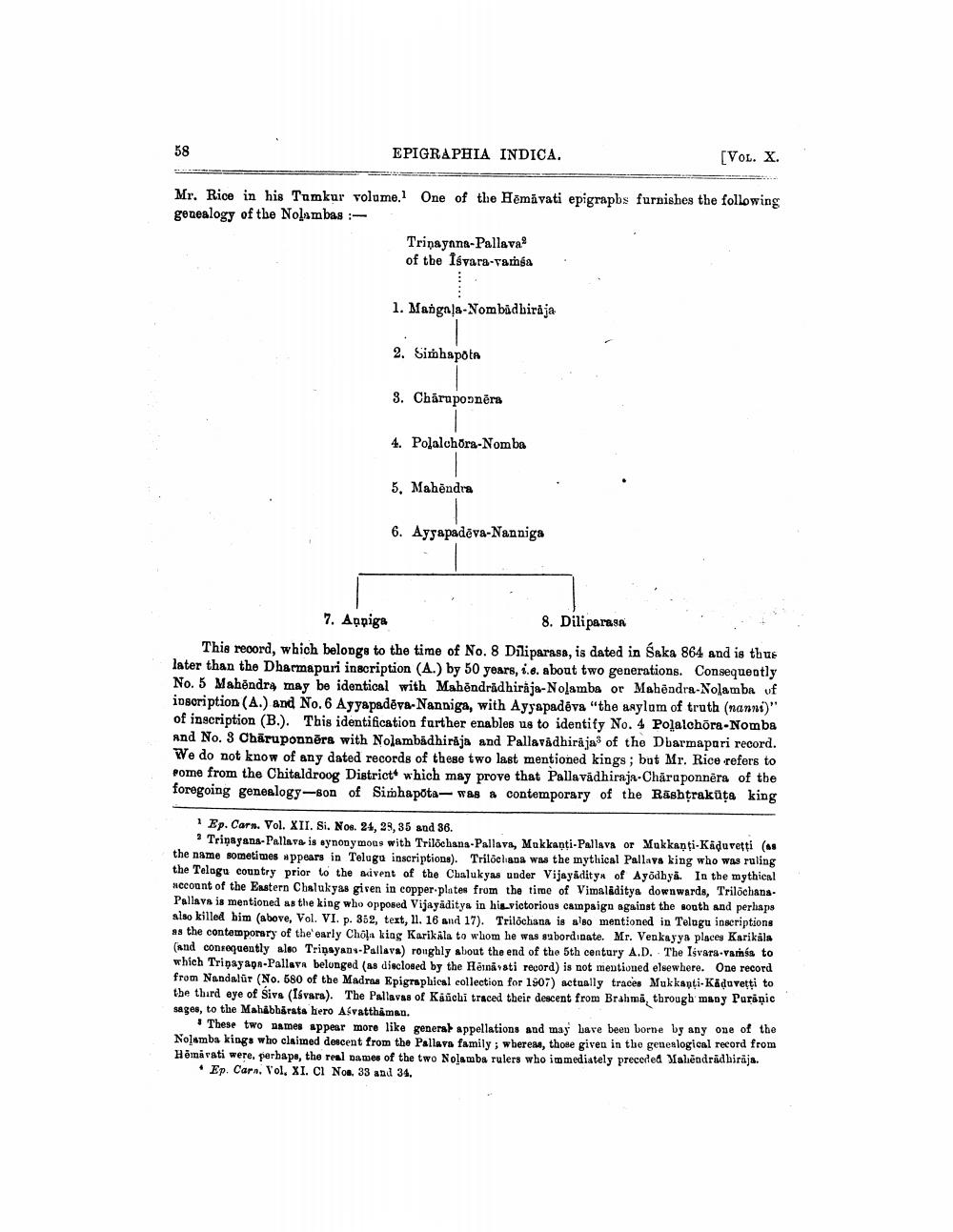________________
58
EPIGRAPHIA INDICA.
[VOL. X.
Mr. Rice in his Tumkur volume. One of the Hēmăvati epigrapbs furnishes the following genealogy of the Nolambas :
Trinaynna-Pallava of the Isvara-vamga
1. Mangaļa-Nombadbiraja
2. Simhapota
3. Chårupoonėra
4. Polalchora-Nomba
5. Mahendra
6. Ayyapadēva-Nanniga
7. Appiga
8. Diliparasai This record, which belongs to the time of No. 8 Diliparasa, is dated in Saka 864 and is thus later than the Dharmapuri inscription (A.) by 50 years, 1.6. about two generations. Consequently No. 5 Mahendra may be identical with Mahendradhiraja-Nolamba or Mahendra-Nolamba uf inscription (A.) and No. 6 Ayyapadēva-Nanniga, with Ayyapadēva "the asylam of truth (nanni)" of inscription (B.). This identification further enables us to identify No. 4 Polalchora-Nomba And No. 3 Chāruponnērs with Nolambadhiraja and Pallavådhirajao of the Dharmapari record. We do not know of any dated records of these two last mentioned kings; but Mr. Rice refers to Pome from the Chitaldroog District which may prove that Pallavādhiraja-Chāruponnēra of the foregoing genealogy-son of Simhapota- was a contemporary of the Rashtrakūta king
Ep. Carn. Vol. XII. Si. Nos. 24, 29, 35 and 36.
? Tripayans-Pallava is synonymous with Trilôchans-Pallava, Mukkanti-Pallava or Mokkanti-Kidureti (as the name sometimes appears in Teluga inscriptions). Trilochana was the mythical Pallava king who was ruling the Telugu country prior to the acivent of the Chalukyas under Vijayadity of Ayodby. In the mythical account of the Eastern Chalukyas given in copper plates from the time of Vimaliditya downwards, Trilochana. Pallava is mentioned as the king who opposed Vijayaditya in his victorious cainpaign against the south and perhaps also killed him (above, Vol. VI. p. 352, text, 11. 16 and 17). Trilochana is also mentioned in Telugu inscriptions as the contemporary of the early Chõļa kiag Karikala to whom he was subordinate. Mr. Venkayya places Karikala (and consequently also Triņayans-Pallava) roughly about the end of the 5th century A.D. The Isvara-vamsa to which Tripayapa-Pallars belonged (as disclosed by the Hérnavati record) is not mentioned elsewhere. One record from Nandalur (No. 580 of the Madras Epigraphical collection for 1907) actually traces Mukkanti-Käduvetti to the third eye of Sivs (Isvara). The Pallavas of Kaichi traced their descent from Brahma, through many Puronic sages, to the Mahabharata hero Asvatthaman.
These two names appear more like general appellations and may bave been borne by any one of the Nolamba kings who claimed descent from the Pallava family; whereas, those given in the genealogical record from Hēmárati were, perhaps, the real names of the two Nolamba rulers who immediately preceded Mahendradbirāja.
• Ep. Carn, Vol. XI. CI Non. 33 and 34.




